1995 BUICK REGAL inflation
[x] Cancel search: inflationPage 33 of 340

I
I A CAUTION:
vehicle strikes something that will move or deform, such
as a parked car, the threshold level will be higher. The
air bag is not designed to inflate
in rollovers, side
impacts, or rear impacts, because inflation would not
help the occupant.
In any particular crash, no one can say whether an air
bag should have inflated simply because of the damage
to
a vehicle or because of what the repair costs were.
Inflation
is determined by the angle of the impact and
the vehicle’s deceleration. Vehicle damage
is only one
indication
of this.
What makes an air bag inflate?
In a frontal or near-frontal impact of sufficient severity,
the air bag sensing system detects that the vehicle is
suddenly stopping as
a result of a crash. The sensing
system triggers
a chemical reaction of the sodium azide
sealed
in the inflator. The reaction produces nitrogen
gas, which inflates the air bag. The inflator, air bag, and
related hardware are all part of the air bag modules
packed inside
the steering wheel and in the instrument
panel
in front of the right front passenger.
1-21
ProCarManuals.com
Page 34 of 340
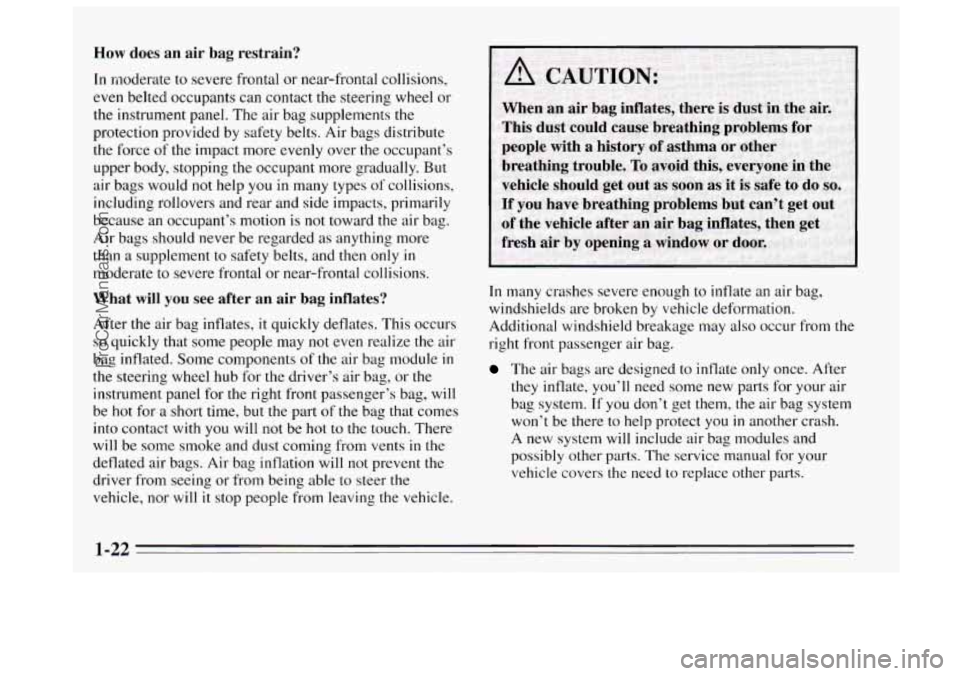
How does an air bag restrain?
In moderate to severe frontal or near-frontal collisions,
even belted occupants
can contact the steering wheel or
the instrument panel. The air bag supplements
the
protection provided by safety belts. Air bags distribute
the force of the impact more evenly over the occupant’s
upper body, stopping the occupant more gradually. But
air bags would not help you in many types of collisions,
including rollovers and rear and side impacts, primarily
because an occupant’s motion is not toward the air bag.
Air bags should never be regarded as anything more
than
a supplement to safety belts, and then only in
moderate to severe frontal or near-frontal collisions.
What will you see after an air bag inflates?
After the air bag inflates, it quickly deflates. This occurs
so quickly that some people may not even realize the air
bag inflated. Some components of the air bag module
in
the steering wheel hub for the driver’s air bag, or the
instrument panel for the right front passenger’s bag, will
be
hot for a short time, but the part of the bag that comes
into contact with you
will not be hot to the touch. There
will be some smoke and dust coming from vents
in the
deflated air bags. Air bag inflation will not prevent the
driver from seeing or from being able to steer the
vehicle, nor will
it stop people from leaving the vehicle. In
many crashes severe enough to inflate an air bag,
windshields are broken by vehicle deformation.
Additional windshield breakage may
also occur from the
right front passenger air bag.
The air bags are designed to inflate only once. After
they inflate,
you’ll need some new parts for your air
bag system.
If you don’t get them, the air bag system
won’t be there to help protect you
in another crash.
A
new system will include air bag modules and
possibly other parts. The service manual for your
vehicle covers the need to replace other parts.
1-22
-- -
ProCarManuals.com
Page 164 of 340
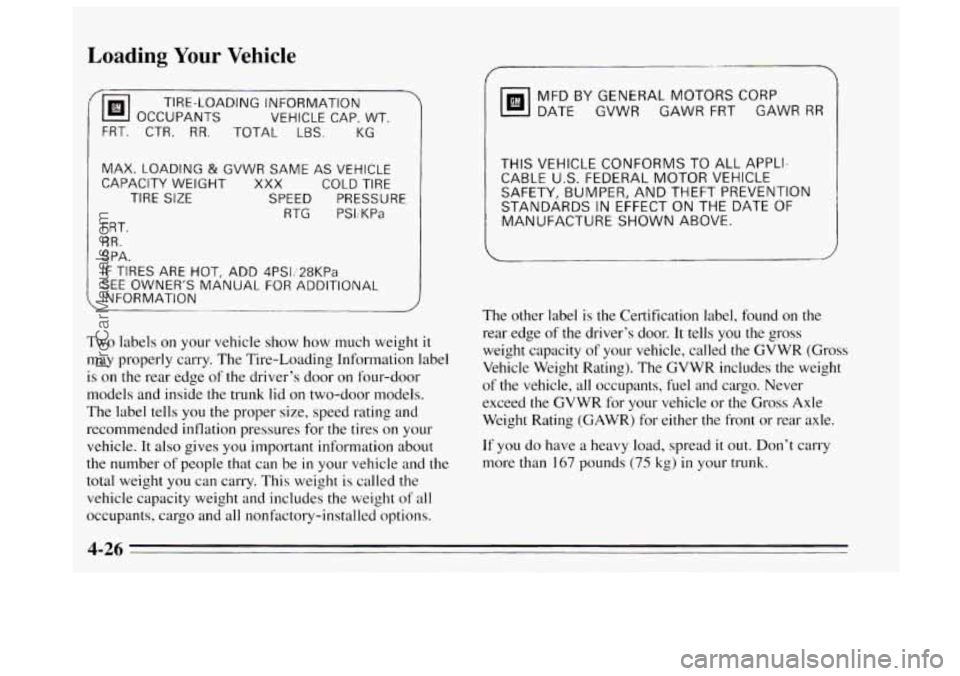
Loading Your Vehicle
OCCUPANTS VEHICLE CAP. WT.
TIRE-LOADING INFORMATION
I FRT. CTR. RR.
TOTAL LBS. KG
MAX.
LOADING & GVWR SAME AS VEHICLE
CAPACITY WEIGHT XXX COLD TIRE
TIRE
SIZE SPEED PRESSURE
RTG
PSIiKPa
FRT.
RR.
SPA.
IF TIRES ARE HOT, ADD 4PSIj28KPa
SEE OWNER’S MANUAL FOR ADDITIONAL
INFORMATION
- ~-__I__-__ -d
Two labels on your vehicle show how much weight it
may properly carry. The Tire-Loading Information label
is on the rear edge of the driver’s door on four-door
models and inside the trunk lid on two-door models.
The label tells you the proper size, speed rating and
recommended inflation pressures for the tires on your
vehicle. It
also gives you important information about
the number of people that can be
in your vehicle and the
total weight you can carry. This weight is called the
vehicle capacity weight and includes the weight of
all
occupants, cargo and all nonfactory-installed options.
/ -- -7
MFD BY GENERAL MOTORS CORP
DATE GVWR GAWR FRT GAWR RR
I
THIS VEHICLE CONFORMS TO ALL APPLI-
CABLE
U.S. FEDERAL MOTOR VEHICLE
SAFETY,
BUMPER, AND THEFT PREVENTION
STANDARDS
IN EFFECT ON THE DATE OF
MANUFACTURE SHOWN ABOVE.
1
The other label is the Certification label, found on the
rear edge of the driver’s door. It tells you the gross
weight capacity of your vehicle, called the GVWR
(Gross
Vehicle Weight Rating). The GVWR includes the weight
of the vehicle, all occupants, fuel and cargo. Never
exceed the GVWR for your vehicle or the Gross Axle
Weight Rating (GAWR) for either the front or rear axle.
If you do have a heavy load, spread
it out. Don’t carry
more than
167 pounds (75 kg) in your trunk.
4-26
ProCarManuals.com
Page 206 of 340

Compact Spare Tire
Although the compact spare was fully inflated when
your vehicle was
new, it can lose air after a time. Check
the inflation pressure regularly. It should be 60 psi
(420 kPa). After installing the compact spare on your
vehicle, you should stop
as soon as possible and make
sure your spare tire
is correctly inflated. The compact
spare is made
to perform well at posted speed limits for
distances
up to 3,000 miles (5 000 km), so you can
finish your trip and have your full-size tire repaired or
replaced where you want.
Of course, it’s best to replace
your spare with
a full-size tire as soon as you can. Your
spare will last longer and be in good shape
in case you
need it again.
1 NOTICE:
Don’t take your compact spare through an
automatic
car wash with guide rails. The
compact spare can get caught on the rails. That
can damage the tire and wheel, and maybe other
parts
of your vehicle.
Don’t use your compact spare on some other vehicle.
And don’t mix your compact spare or wheel
with other
wheels or tires. They won’t
fit. Keep your spare and its
wheel together.
NOTICE:
Tire chains won’t fit your compact spare. Using
them will damage your vehicle and destroy the
chains too. Don’t use tire chains on your compact
spare.
5-32
ProCarManuals.com
Page 239 of 340
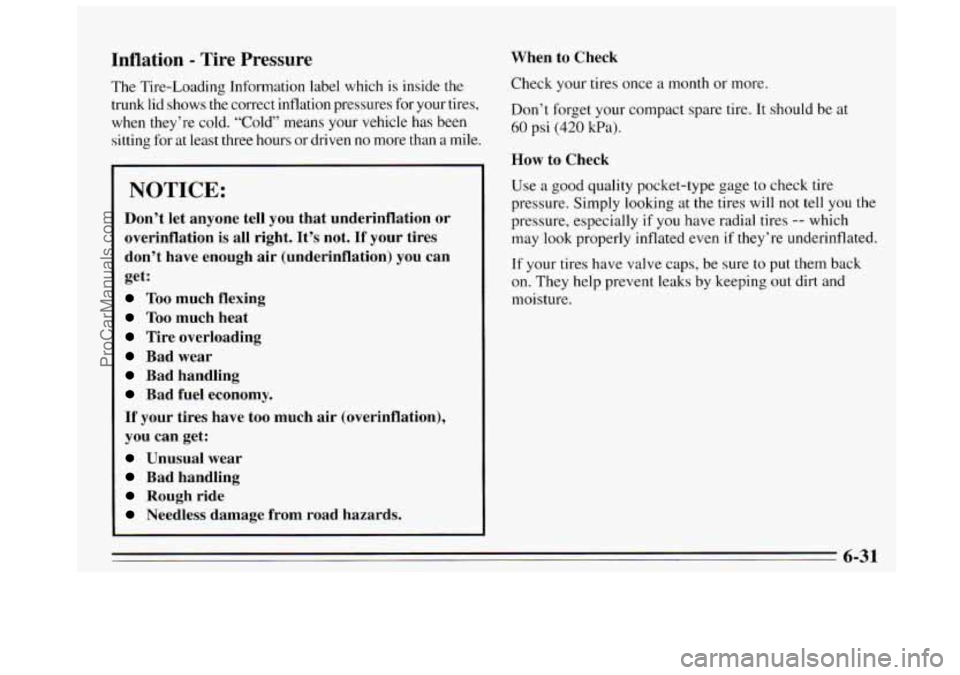
Inflation - Tire Pressure
The Tire-Loading Information label which is inside the
trunk lid shows the correct inflation pressures for your tires,
when they’re cold. “Cold” means your vehicle has been
sitting for at least three hours or driven no more than a mile.
NOTICE:
Don’t let anyone tell you that underinflation or
overinflation is all right. It’s not.
If your tires
don’t have enough
air (underinflation) you can
get:
Too much flexing
Too much heat
Tire overloading
Bad wear
Bad handling
Bad fuel economy.
If your tires have too much air (overinflation),
you can get:
Unusual wear
Bad handling
Rough ride
Needless damage from road hazards. When to Check
Check
your tires once a month or more.
Don’t forget your compact spare tire. It should be at
60 psi (420 kPa).
How
to Check
Use a good quality pocket-type gage to check tire
pressure. Simply looking at the tires will
not tell you the
pressure, especially
if you have radial tires -- which
may look properly inflated even if they’re underinflated.
If your tires have valve caps, be sure
to put them back
on. They help prevent leaks by keeping out dirt and
moisture.
6-31
ProCarManuals.com
Page 240 of 340
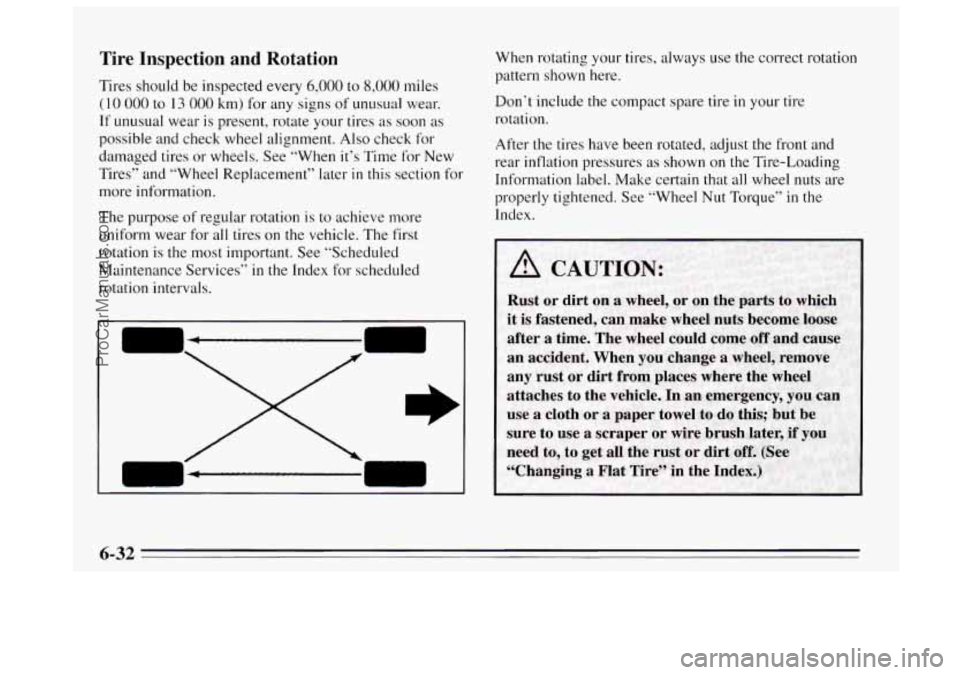
Tire Inspection and Rotation
Tires should be inspected every 6,000 to 8,000 miles
(I 0 000 to 13 000 km) for any signs of unusual wear.
If unusual wear is present, rotate your tires as soon as
possible and check wheel alignment. Also check for
damaged tires or wheels. See “When
it’s Time ,for New
Tires” and “Wheel Replacement” later
in this section for
more information.
The purpose of regular rotation is to achieve more
uniform wear for all tires on the vehicle. The first
rotation is the most important. See “Scheduled
Maintenance Services”
in the Index for scheduled
rotation intervals. When
rotating your tires, always use the correct rotation
pattern shown here.
Don’t include the compact spare tire
in your tire
rotation.
After the tires have been rotated, adjust the front and
rear inflation pressures
as shown on the Tire-Loading
Information label. Make certain that all wheel nuts are
properly tightened. See “Wheel
Nut Torque” in the
Index.
6-32
ProCarManuals.com
Page 243 of 340
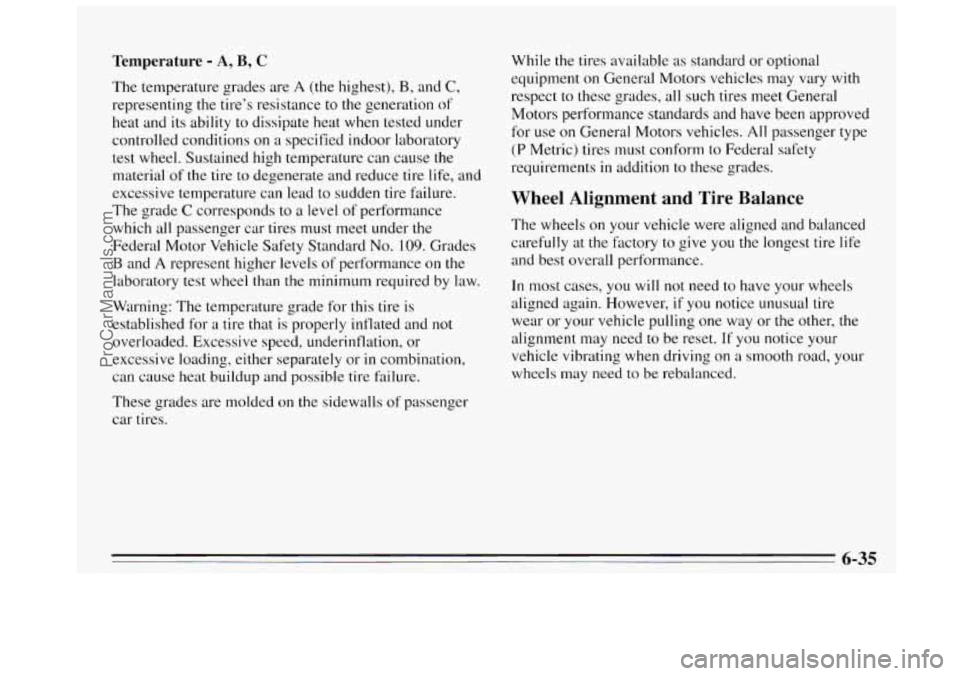
Temperature - A, B, C
The temperature grades are A (the highest), B, and C,
representing the tire’s resistance to the generation of
heat and its ability to dissipate heat when tested under
controlled conditions on
a specified indoor laboratory
test wheel. Sustained high temperature can cause the
material
of the tire to degenerate and reduce tire life, and
excessive temperature can lead to sudden tire failure.
The grade
C corresponds to a level of performance
which all passenger car tires must meet under the
Federal Motor Vehicle Safety Standard
No. 109. Grades
B and A represent higher levels of performance on the
laboratory test wheel than the minimum required by law.
Warning: The temperature grade for this tire is
established for
a tire that is properly inflated and not
overloaded. Excessive speed, underinflation, or
excessive loading, either separately
or in combination,
can cause heat buildup and possible tire failure.
These grades are molded
on the sidewalls of passenger
car tires. While the tires
available
as standard or optional
equipment on General Motors vehicles may vary with
respect to these grades, all such tires meet General
Motors performance standards and have been approved
for use
on General Motors vehicles. All passenger type
(P Metric) tires must conform to Federal safety
requirements
in addition to these grades.
Wheel Alignment and Tire Balance
The wheels on your vehicle were aligned and balanced
carefully at the factory to give you the longest tire
life
and best overall performance.
In most cases, you will
not need to have your wheels
aligned again. However,
if you notice unusual tire
wear or
your vehicle pulling one way or the other, the
alignment may need
to be reset. If you notice your
vehicle vibrating when driving on a smooth road, your
wheels may need
to be rebalanced.
6-35
ProCarManuals.com
Page 269 of 340

Section 7 Maintenance Schedule
IMPORTANT:
KEEP ENGINE OIL
AT THE PROPER
.EVEL AND CHANGE AI
RECOMMENDED
This section covers the maintenance required for your
Buick. Your vehicle needs these services
to retain its
safety, dependability
and emission control performance.
Protection
Plan
ui
Introduction
Your Vehicle and the Environment
Proper vehicle maintenance not only helps to keep your
vehicle
in good working condition, but also helps the
environment. All recommended maintenance procedures
are important. Improper vehicle maintenance or the
removal
of important components can significantly
affect the quality
of the air we breathe. Improper fluid
levels or
even the wrong tire inflation can increase the
level of emissions from your vehicle. To help protect our
environment, and to help keep
your vehicle in good
condition, please maintain your vehicle properly.
ProCarManuals.com